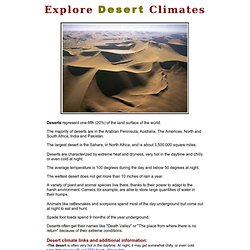

Information on Desert Climates. Deserts represent one-fifth (20%) of the land surface of the world.

The majority of deserts are in the Arabian Peninsula, Australia, The Americas, North and South Africa, India and Pakistan. The largest desert is the Sahara, in North Africa, and is about 3,500,000 square miles. Deserts are characterized by extreme heat and dryness, very hot in the daytime and chilly or even cold at night.
The average temperature is 100 degrees during the day and below 50 degrees at night. Desert Habitat Facts - Defenders of Wildlife. Deserts. Far from being barren wastelands, deserts are biologically rich habitats with a vast array of animals and plants that have adapted to the harsh conditions there.

Some deserts are among the planet's last remaining areas of total wilderness. Yet more than one billion people, one-sixth of the Earth's population, actually live in desert regions. Deserts cover more than one fifth of the Earth's land, and they are found on every continent. A place that receives less than 10 inches (25 centimeters) of rain per year is considered a desert. San Diego Zoo's Animal Bytes: Deserts. What's It Like Where You Live? American Desert Biomes - Desert Environments - World Desert Biomes. Deserts cover more than one fifth of the Earth's land, and they are found on every continent.

Deserts can be classified as "hot" or "cold". Deserts receive less than 10 inches of precipitation a year. Lack of water creates a survival problem for all desert organisms, animals, plants and people. What is a desert? Learn about how deserts are classified and about the plant and animal life that adapt to the desert biome.